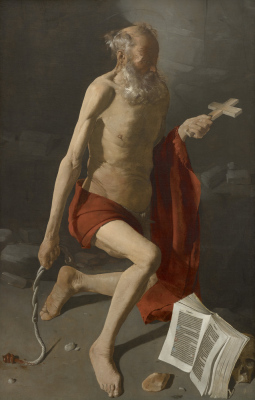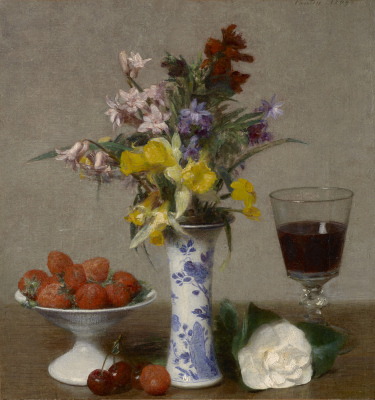the museum in english
With its collections of ancient, modern, and contemporary art, the Musée de Grenoble offers you a chance to travel through the history of western painting from the 13th to the 20th century. Exhibited are some of the finest masterpieces from classical Flemish, Dutch, Italian, and Spanish painting; one of the 20th century richest European collections; and all the great post-1945 contemporary art movements, right up to the most recent artworks of the 2000s.
Pratical information
Access
Musée de Grenoble
5, place de Lavalette
38010 Grenoble cedex 1
Telephone: 04 76 63 44 44
Opening hours
The museum is open daily, except Tuesday, from 10 am to 6.30 pm.
Closed on January 1st, May 1st, December 25th
Tickets prices
(may be subject to modification in certain circumstances)
SERVICES |
FEES
|
| Visit of the permanent collections | Free admission |
| Main temporary exhibition | Full price €14 / Reduced fee €7*. |
| Other temporary exhibitions | Free admission |
* Reduced fee, on presentation of proof of entitlement:
Large families (SNCF cards or family record book); Alices, Savatou Isère cards; Members of the Comité Social de la Ville de Grenoble; Societies of Friends of Museums; Grenoble City pass rate, Associations and partners under agreement; SEMITAG season ticket holders (on presentation of a valid season ticket); Grenoble residents on presentation of proof of address less than 3 months old.
Free admission on presentation of proof of entitlement:
Young people under the age of 26; jobseekers; recipients of minimum social benefits (RSA, minimum old-age pension, etc. ); disabled persons and 1 accompanying person; veterans; asylum seekers; school groups accompanied by teachers; ICOM (International Council of Museums) card holders; AICA (International Association of Art Critics) / press / COMEX; members of the Société des Amis du musée de Grenoble (SAMG); artists on presentation of the Maison des artistes card (Paris or Regions); partners authorised by agreement with the City of Grenoble.
Free admission for all:
The 1st Sunday of each month and local or national events: Musées en fête, Nuit des musées, Nocturne des étudiants, Journées Européennes du Patrimoine, Printemps du Livre within the museum.
Guided tours
Groups (20 pers): 150€ for a guided visit
Guided tours can be organized in French, English and Italian.
Private events
For more information about hosting events at the Museum please fill in this form.
At the museum
The library
Open from Monday to Friday (except Tuesday) from 2 to 6 pm
The arts and youth reading corner open every Wednesday from 2 to 6pm
The bookshop-boutique
Open every day (except Tuesday) from 10.30 am to 1 pm and from 2 to 6.30 pm
Les Amis du musée de Grenoble/Friends of the Musée de Grenoble
All year round, on Monday, Wednesday and Thursday from 2.30 to 6 pm, except public holidays.
Telephone : 04 76 63 44 29. Fax : 04 76 63 44 56
Musée en musique/Music at the Museum
All year round, on Monday, Wednesday, Thursday and Friday from 10.30 am to 12.30 pm and from 2 to 6.30 pm.
Telephone : 04 76 87 77 31. Fax : 04 76 87 77 61.
Le Café-Restaurant "andry"
The café-restaurant "andry" is open daily (except Tuesday). The access is separate from the museum.
Telephone : 04 76 25 80 26
The Collections
Presented in chronological order, the collections, bringing together some 800 painted and sculpted works, are displayed into two distinct large sections. The first is devoted both to the great painting schools of the 13th to 19th centuries and to 17th century Europe with artists such as Rubens, Georges de La Tour, Philippe de Champaigne, La Hyre and Zurbarán, giving the antique art collection its rich splendor.The 19th century is illustrated by a set of works ranging from Neo-classicism to Impressionism, enhanced by great names such as Delacroix, Pradier, Fantin-Latour, Monet, and Gauguin.
The second section presents key works from 20th century modern art through a range of notorious artists including Matisse, Picasso, Léger, and Ernst among many others, then travels through art history to reach creators from the contemporary period, presenting works by Soulages, Warhol, Naman, Boltanski, and Schütte who deeply contributed to the museum's prestige.
This collection is complemented by an extensive selection of drawings of great quality, as well as Egyptian, and Greek and Roman archaeological artifacts.
-
L'Annonciation
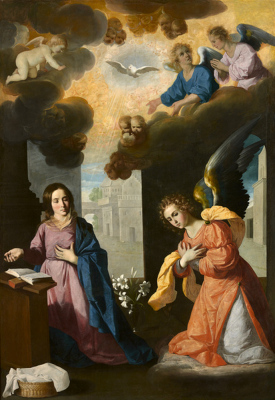
Médium :
Auteur : Francisco de ZURBARAN
Date : 1638 - 1639
Dimension : 266 x 184,5 cm
Crédit : Ville de Grenoble / Musée de Grenoble-J.L. LacroixDomaine public
Acquisition : Don de Léon de Beylié en 1901
Localisation : SA08 - Salle 08Zurburàn, together with Velazquez and Murillo, was the greatest Spanish painter of the Golden Age. This picture, along with the three others, comes from the large altarpiece in the Charterhouse at Jerez de la Frontera, which was taken apart in 1837. The four canvases, which were acquired by General de Beylié in 1904, were immediately offered to the museum.
This triumphal Annunciation was painted with the requirement that the work be readable with the instructions of the exegetes of the Counter-Reformation. The distribution from left to right, from the Virgin to the Angel, is segmented by the vertical lines of the columns linking heaven and earth. This arrangement grants the composition a powerfully frontal aspect. The alternating dark and light areas, and the improbable inclusion of the landscape in the background give the decor a intense theatrical look.
Zurburàn rejected the Mannerist decorative excess. He was careful to isolate the objects, which thus take on an unusual monumental presence. The symbolic meaning of the still life elements — the lilies, the white linen, and the book—goes hand in hand with a meditative aura emphasized by the solemn, contemplative attitude of the figures. The latter, idealized without mawkishness, face the onlooker and bear witness to the fulfillment of the divine will. The colour, modulated by the light, lends a forceful relief to the elements in the lower register. The treatment of the sky and the angels is in a mellowed, more diffused style. This work, probably the last to be made for the altarpiece, shows Zurburàn’s receptiveness to Italian-inspired influences. -
Saint Grégoire pape, entouré de saints et de saintes, vénérant l'image miraculeuse de la Vierge à l'Enfant, dite de Santa Maria in Vallicella
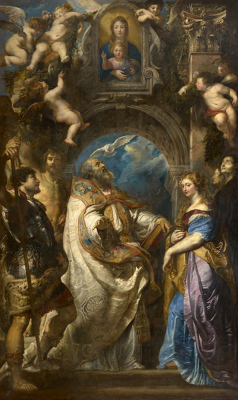
Médium : Huile sur toile
Auteur : Pietrus Paulus RUBENS
Date : 1606 - 1607
Dimension : 477 x 288 cm
Crédit : Ville de Grenoble / Musée de Grenoble-J.L. LacroixDomaine public
Acquisition : Dépôt de l'Etat en 1811
Localisation : SA02 - Salle 02This major work from the Flemish collection is a dazzling evidence of Rubens' first period, prior to his return from Italy in late 1608. Commissioned in 1606 by the Oratorian Fathers for the Chiesa Nuova di Santa-Maria-in-Valicella in Rome, St. Gregory was refused by the latter, and was displayed in the artist's funerary chapel in Antwerp until the 18th century.
St. Gregory, pope from 590 to 604, is at the centre of the composition, accompanied by the dove of the Holy Ghost. On the right, St. Domitilla appears in luxurious clothes just before St.Achilleus and St. Nereus. On the left, St. Maurus, presented as a Roman soldier stands beside St. Papianus leaning on a stick. At the very top of the arch is an image of the Virgin with Child giving its blessing, surrounded by cherubs. The monumental arch rounds off the scene, perfectly illustrating the spirit of the triumphant Counter-Reformation.
The composition is partitioned by a succession of diagonals leading to the portrait of the Virgin, a picture within a picture. The remarkable refinement of St.Gregory's apparel reminisces the painter's origins. Nevertheless, the Italian, and more specifically Venetian influences are rather predominant. The Baroque components - the characters' overall presentation, the swirling movement of the robes, and the interplay of gazes, predict the Rubens to come.
The research undertaken over the past few years regarding the complex genesis of this painting will result in an illustrated book, along with an audiovisual guide recounting the complete history of this masterpiece.
-
Saint Jérôme pénitent Dit aussi Saint Jérôme à l'auréole
Médium : Huile sur toile
Auteur : Georges de LA TOUR
Date : vers 1628 - 1630
Dimension : 157 x 100 cm
Crédit : Ville de Grenoble / Musée de Grenoble-J.L. LacroixDomaine public
Acquisition : Saisie révolutionnaire en 1799, entré au musée en 1800 (provient de l'abbaye de Saint-Antoine-en-Viennois).
Localisation : SA07 - Salle 07Renowned in his days but totally forgotten after his death, the recent research and exhibitions dedicated to Georges de La Tour have given the artist a new prominent place within French 17th century painting.
His genre scenes and religious pictures are imbued with an entirely re-appropriated Caravaggio-like inspiration. This St. Jerome, which comes from the Abbey Church of Saint-Antoine en Viennois, is a noteworthy masterpiece of the collection. The monumental figure of the injured saint lost in meditation seems to bow to the canvas' format, contained within a cramped space. On a bare and somber background, the silhouette of the old man stands out, offering us his worn flesh and the frailty of his human condition.The construction of the body, using large diagonals, heightens the architectural and monumental aspects of the figure, also emphasized by the lateral lighting. The monochrome palette of the decor highlights both the beige hue of the skin and the drapery's restrained red. The fine, thin paint of the whole piece becomes thicker with virtuous brushstrokes in the saint's hair and beard.
The open Bible which Jerome was one of the first to translate, the blood-fleckered cord of penitence, the skull, and the firmly clutched crucifix are all elements which bolster the high spirituality of the scene. As with the most of de La Tour's works which were repeated in several versions, another less austere St. Jerome is held in the National Museum of Stockholm.
-
Nature morte dite "de fiançailles"
Médium :
Auteur : Henri FANTIN-LATOUR
Date : 1869
Dimension : 32,8 x 30,4 cm
Crédit : Ville de Grenoble / Musée de Grenoble-J.L. LacroixDomaine public
Acquisition : Legs de Victoria Fantin-Latour née Victoria Dubourg en 1921, entré au musée en 1926
Localisation : SA22 - Salle 22This small, balanced, and harmonious masterpiece was the engagement gift offered by the artist to his bride-to-be, Victoria Dubourg. Displayed in the exhibition room is also a portrait of her, painted by Fantin-Latour in 1877.
Between 1864 and 1896 Fantin-Latour produced more than 800 pictures of flowers. He would prepare his palette the day before, and pick his flowers that same morning, before setting to work.In order to reduce the space depth-wise, he would arrange the bouqet before a neutral-coloured basket and lit the flowers with a filtered light. Usually, the decor was nothing more than a simple table. The cherries and the small bowl of strawberries, along with the camellia and the glass of wine are all organized around the arrangement of spring flowers set at the very centre of the composition.The discreet interplay of proportions and the subtle balance of the colours create a gentle, peaceful atmosphere. The creamy whites and purplish blues contrast with the various reds, ranging from the opaque purple of the wine to the pale pink of the hyacinths.
In 1863, Fantin-Latour took part in the famous “Salon des refuses”. He was close to the Impressionists, but never adopted their technique as he did not enjoy painting outside. Nevertheless, his light touch and the blurred aspect of certain outlines reminisce the freedom so dear to outdoor painters.
Born in Grenoble in 1836, the artist left the city at the age of five. After his death, his widow made a considerable bequest to the museum, including this work among a few others. -
Sicile
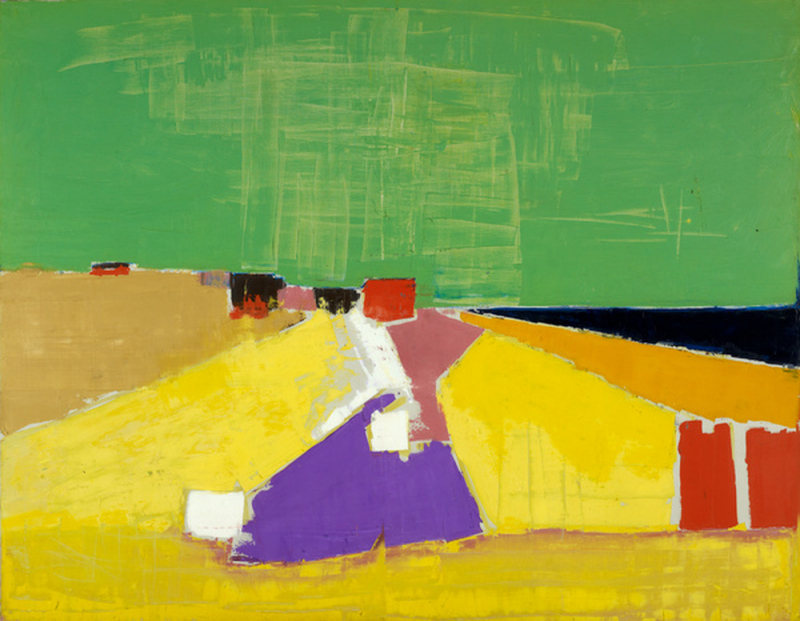
Médium :
Auteur : Nicolas de STAËL
Date : 1954
Dimension : 114 x 146 cm
Crédit : VILLE DE GRENOBLE / MUSÉE DE GRENOBLE-J.L. LACROIX© Adagp, Paris
Acquisition : Achat à Françoise de Staël avec la participation du FRAM en 1982
Localisation : SA37 - Salle 37Nicolas de Staël, painter of Russian origins, settled in Paris in 1938. In the early 1940s, he discovered abstraction among artists like Magnelli and Delaunay. His style, consisting of surfaces covered with dazzling colours crushed with a knife or spatula, asserted the power of the stroke. Influenced by the outstanding quality of light in the south of France and Sicily, where he went in 1953, the effects of partial transparency attained by lightening the paint created, in his painting, a vibrancy and a vitality hitherto never achieved. Earth, sea, sky, and architecture were all conveyed through large swathes of colour of varying thickness.
The lower half of the canvas has warm shades of colour applied in thick layers. Standing out against this sand and these ochre lands, we find red, pink, and mauve surfaces, and two white squares with irregular outlines. The upper half contains just the green of the sky, which transparency reveals the canvas just beneath. All the lines of the landscape converge towards the central red area, key to the composition. The impasto effects, inconspicuous here, emphatic there, allow the colour to act with a maximum degree of intensity. The juxtaposition of the coloured planes gives visibility to an unpainted edge which calls to mind the technique of torn paper and collage practiced by the artist. By expressing his vision of a natural site through brilliant colours, Nicolas de Staël, the most famous painter from the Ecole de Paris, turned the landscape into a new genre in modern painting. -
Le Songe d'une nuit d'été
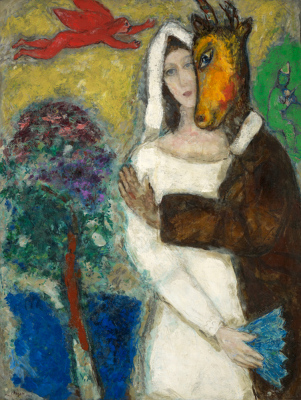
Médium :
Auteur : Marc CHAGALL
Date : 1939
Dimension : 116,5 x 89 cm
Crédit : VILLE DE GRENOBLE / MUSÉE DE GRENOBLE-J.L. LACROIX© Adagp, Paris
Acquisition : Don de l'artiste en 1951
Localisation : SA34 - Salle 34Even though Marc Chagall spent the majority of his life in France, first in Paris and the in Vence, he remained committed to his birth country, Russia, for a very long time; returning 'home' to carry out official functions between 1914 and 1922. Among the bodies of work by artists from the Ecole de Paris, Chagall's art remains imbued with a very personal philosophical and poetic force. The observation of day-to-day reality through the prism of Fauve and Cubist influences is conveyed by a "total lyrical explosion", to borrow André Breton's expression.
Chagall evolves from his inner reality towards a world encompassing figures which elude any verisimilitude as in Midsummer Night's Dream. Painted during the artist's Parisian period, the theme of this picture revolves around William Shakespeare's comedy, which the painter situated in a dream-like forest inhabited by slyphs and lovers. The bewitched Queen of the fairies, Titania, falls for a donkey-headed weaver, Bottom. The woman, clad in a white wedding gown and a veil recurs in an almost identical form in several pictures from that period, sometimes with the same blue fan. Winged beings and violinists are also often depicted.
Resorting to the fabulous, Chagall reconciles the image of reality with a fable. The naivety of the perspective-less composition combined wiht the contrast of juxtaposed touches of colour create a "magical" pictorial space.
-
La Fenêtre
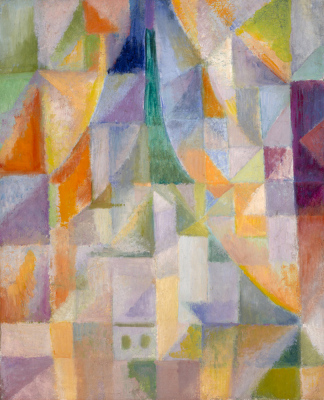
Médium :
Auteur : Robert DELAUNAY
Date : 1912
Dimension : 45,8 x 37,5 cm
Crédit : VILLE DE GRENOBLE / MUSÉE DE GRENOBLE-J.L. LACROIXDomaine public
Acquisition : Achat à J. Mathellot en 1948
Localisation : SA28 - Salle 28As the pioneer of abstraction, Robert Delaunay deeply contributed to the European movement developed right before WWI that would completely revolutionize representation. Tutored by a theatre set designer, Delaunay turns his attention to the material and spatial aspects of colour, a fescination prevailing over his interest for cubism inspired by Monet and the 1907 Cézanne retrospective. In comparison to Malévitch and Mondrian's essentialist abstraction, Delaunay introduces an optical adventure, focusing on the visual and autonomous nature of paint.
The set of Fenêtres, painted between 1912 and 1913, is an embodiment of pure paint. The pictorial plane, entirely composed of coloured facets, and the window frame overlaying the painting's edge create a remarkable kaleidoscope. Stimulated by the idea that painting solely relies on colour contrast, Delaunay plays with the contiguity and complemetarity of various shades, creating subtle vibrant movements on the pictorial plane. The rough outline of the Eiffel Tower in the centre of the composition appears as the last material detail, an icon of modernity. Following their creation, Fenêtres is first exhibited at the Kunsthaus in Zurich, then in Paris, and becomes a symbol of abstraction highlighting a new reality, a vision of modernity.
-
Femme lisant
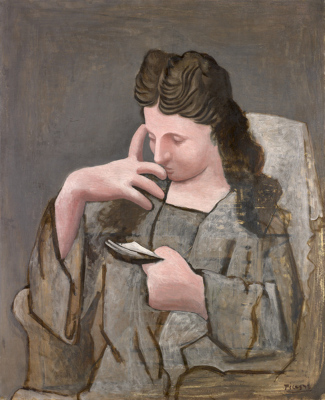
Médium :
Auteur : Pablo PICASSO
Date : 1920
Dimension : 100 x 81,2 cm
Crédit : VILLE DE GRENOBLE / MUSÉE DE GRENOBLE-J.L. LACROIX© Succession Picasso
Acquisition : Don de l'artiste en 1921In 1917, Picasso stayed in Rome to produce the sets for Diaghilev’s ballet Parade.There, he met Olga Kokhlova, dancer with the Ballets Russes, and rediscovered antique statuary, Etruscan art, and early Renaissance painting. As a result, the works produced during these years were impacted by the appearance of monumental, gigantic, old-fashioned human forms.
Woman Reading, presenting a hieratic figure drawn after Olga whom Picasso married in 1918, conveys the virtuous juxtaposition of Classicism and Cubism. The swollen pink flesh of the face and hands, along with the position of the finger placed on the temple remind us of Picasso’s interest in the characteristic drawing and deformation of Jean-Auguste-Dominique Ingres' art, and more particularly the Portrait of Madame Moitessier painted in 1856. The nose and the arch of the eyebrows both evoke the regularity of faces in antique statues. The bust and the clothing with its flattened folds, as well as the monochrome palette of greys and browns make a reference to the period of analytical deconstruction in Cubism (1910-1912). The hair, styled with long, wavy locks, suggests a note of freedom and refers to carving techniques. The impressive grey-clad figure barely stands out against the more neutral grey background, matching tones which emphasize the flesh tints. The atmosphere of serenity released by this scene is both due to the restricted choice of colours and to the sculptural aspect of the deeply focused figure.

